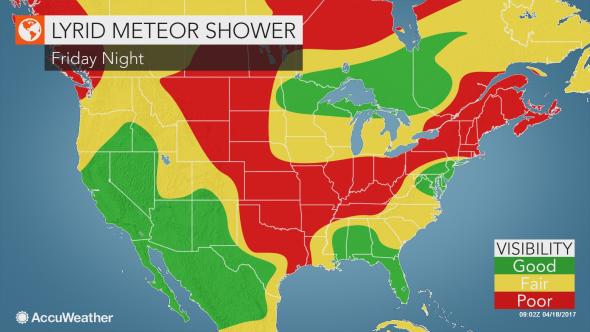
SOUTHERN UTAH — Neither the clouds nor the moon will dampen this year’s Lyrid meteor shower as it reaches its peak Friday night, according to experts. The dazzling light show is expected to be visible for much of the nation and may produce occasional fireballs.
Every year in April, Earth passes through the dusty tail of Comet Thatcher. This encounter creates the Lyrid meteor shower as flakes of comet dust, most no bigger than grains of sand, strike Earth’s atmosphere traveling 110,000 mph. The comet dust then disintegrates as streaks of light.

The meteor shower officially kicked off Sunday and will reach its peak late Friday night and early Saturday morning. Light from the moon will not interfere with viewing conditions as the peak falls just a few days before the new moon, making 2017 an excellent year for viewing the Lyrids, according to NASA.
While the Lyrid meteors usually lack persistent trains, they can produce fireballs, according to the American Meteor Society.
Fireballs are meteors that become extremely bright as they burn up entering the Earth’s atmosphere and can light up the entire sky for a few brief seconds. The intense Lyrid fireballs, which display even brighter than the magnitude of Venus in the night sky, cast shadows for a split second and leave behind smoky debris trails that linger for minutes.
Typical Lyrid meteors are about as bright as the stars of the Big Dipper and are relatively mild.
The average Lyrid shower produces 15 to 20 meteors per hour, NASA meteor expert Bill Cooke told Space.com.
Some years, the Lyrid meteor shower intensifies when Earth glides through an unusually dense clump of debris from Comet Thatcher and can produce up to 100 meteors per hour in what’s called an “outburst.” However, it is difficult to predict exactly when that will happen.
In 1803, a journalist in Richmond, Virginia, documented an impressive Lyrids display:
Shooting stars. This electrical phenomenon was observed on Wednesday morning last at Richmond and its vicinity, in a manner that alarmed many, and astonished every person that beheld it. From one until three in the morning, those starry meteors seemed to fall from every point in the heavens, in such numbers as to resemble a shower of sky rockets …
Lyrid viewing tips
NASA provided the following tips to make watching the meteor shower more enjoyable:
- The Lyrids are best viewed in the Northern Hemisphere during the dark hours (after moonset and before dawn).
- Find an area well away from city or street lights.
- Be prepared with a sleeping bag, blanket or lawn chair.
- Lie flat on your back with your feet facing east and look up, taking in as much of the sky as possible.
- After about 30 minutes in the dark, your eyes will adapt and you will begin to see meteors.
- Be patient – the show will last until dawn, so you have plenty of time to catch a glimpse.
Friday night’s Lyrid meteor shower may be the best meteor shower for the Northern Hemisphere until the peak of the Orionid meteor shower in late October, according to Accuweather.com.
While there are several meteor showers between April and October, the peaks of these showers all occur within a few days of the full moon, making the meteors difficult to spot.
Email: [email protected]
Twitter: @STGnews
Copyright St. George News, SaintGeorgeUtah.com LLC, 2017, all rights reserved.